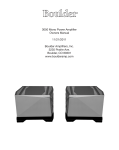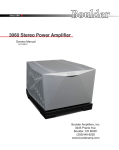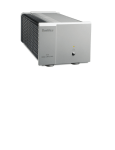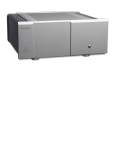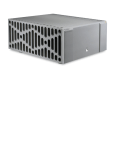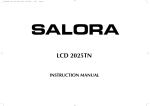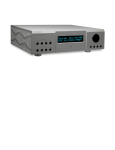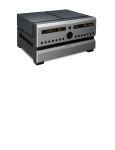Download Boulder 1008 Specifications
Transcript
Boulder 1008 Phono Preamplifier Owners Manual V1.0 10/20/2009 Boulder Amplifiers, Inc. 3235 Prairie Ave. Boulder, CO 80301 www.boulderamp.com APPENDIX RECORDING EQUALIZATION OPERATION CARTRIDGE SET UP GETTING STARTED TABLE OF CONTENTS GETTING STARTED Placement of the 1008 Phono Preamplifier. . . . . . . . . . . . . . . . . . . . . . . . . . . . . . . . . . . . . . 1-1 Connecting to the Mains Outlet . . . . . . . . . . . . . . . . . . . . . . . . . . . . . . . . . . . . . . . . . . . . . . . 1-2 Connecting to a Turntable . . . . . . . . . . . . . . . . . . . . . . . . . . . . . . . . . . . . . . . . . . . . . . . . . . . . 1-3 Phono Cables Diagram. . . . . . . . . . . . . . . . . . . . . . . . . . . . . . . . . . . . . . . . . . . . . . . . . . . . . . . 1-4 Connecting to a Balanced Input Preamplifier. . . . . . . . . . . . . . . . . . . . . . . . . . . . . . . . . . . . 1-5 Connecting to an Unbalanced Input Preamplifier. . . . . . . . . . . . . . . . . . . . . . . . . . . . . . . . 1-6 CARTRIDGE SETUP Personality Card . . . . . . . . . . . . . . . . . . . . . . . . . . . . . . . . . . . . . . . . . . . . . . . . . . . . . . . . . . . . 2-1 Moving Coil or Moving Magnet . . . . . . . . . . . . . . . . . . . . . . . . . . . . . . . . . . . . . . . . . . . . . . 2-2 Cartridge Loading – Resistive. . . . . . . . . . . . . . . . . . . . . . . . . . . . . . . . . . . . . . . . . . . . . . . . . 2-3 Cartridge Loading – Capacitive . . . . . . . . . . . . . . . . . . . . . . . . . . . . . . . . . . . . . . . . . . . . . . . 2-4 OPERATION Powering Up. . . . . . . . . . . . . . . . . . . . . . . . . . . . . . . . . . . . . . . . . . . . . . . . . . . . . . . . . . . . . . . . 3-1 Input Selection. . . . . . . . . . . . . . . . . . . . . . . . . . . . . . . . . . . . . . . . . . . . . . . . . . . . . . . . . . . . . . 3-2 Mono. . . . . . . . . . . . . . . . . . . . . . . . . . . . . . . . . . . . . . . . . . . . . . . . . . . . . . . . . . . . . . . . . . . . . . 3-2 Equalization . . . . . . . . . . . . . . . . . . . . . . . . . . . . . . . . . . . . . . . . . . . . . . . . . . . . . . . . . . . . . . . . 3-3 Low Cut Filter . . . . . . . . . . . . . . . . . . . . . . . . . . . . . . . . . . . . . . . . . . . . . . . . . . . . . . . . . . . . . . 3-4 Mute. . . . . . . . . . . . . . . . . . . . . . . . . . . . . . . . . . . . . . . . . . . . . . . . . . . . . . . . . . . . . . . . . . . . . . . 3-5 APPENDIX RECORDING EQUALIZATION OPERATION CARTRIDGE SET UP GETTING STARTED EQUALIZATION Equalization Curves . . . . . . . . . . . . . . . . . . . . . . . . . . . . . . . . . . . . . . . . . . . . . . . . . . . . . . . . . 4-1 RIAA Reproduce Curve. . . . . . . . . . . . . . . . . . . . . . . . . . . . . . . . . . . . . . . . . . . . . . . . . . . . . . 4-2 FFRR Reproduce Curve . . . . . . . . . . . . . . . . . . . . . . . . . . . . . . . . . . . . . . . . . . . . . . . . . . . . . . 4-3 EMI Reproduce Curve . . . . . . . . . . . . . . . . . . . . . . . . . . . . . . . . . . . . . . . . . . . . . . . . . . . . . . . 4-4 Columbia Reproduce Curve . . . . . . . . . . . . . . . . . . . . . . . . . . . . . . . . . . . . . . . . . . . . . . . . . . 4-5 USING A RECORDER Connections . . . . . . . . . . . . . . . . . . . . . . . . . . . . . . . . . . . . . . . . . . . . . . . . . . . . . . . . . . . . . . . . 5-1 APPENDIX Block Diagram. . . . . . . . . . . . . . . . . . . . . . . . . . . . . . . . . . . . . . . . . . . . . . . . . . . . . . . . . . . . . . 6-1 Specifications . . . . . . . . . . . . . . . . . . . . . . . . . . . . . . . . . . . . . . . . . . . . . . . . . . . . . . . . . . . . . . . 6-2 Troubleshooting. . . . . . . . . . . . . . . . . . . . . . . . . . . . . . . . . . . . . . . . . . . . . . . . . . . . . . . . . . . . . 6-3 Notes. . . . . . . . . . . . . . . . . . . . . . . . . . . . . . . . . . . . . . . . . . . . . . . . . . . . . . . . . . . . . . . . . . . . . . 6-5 APPENDIX RECORDING EQUALIZATION OPERATION CARTRIDGE SET UP GETTING STARTED GETTING STARTED PLACEMENT OF THE 1008 PHONO PREAMPLIFIER Your Boulder 1008 Preamplifier is designed to reduce interference from external magnetic and radio fields (RF). While placement is not critical, known magnetic fields should be avoided. Power transformers in other pieces of nearby equipment should be kept away by 1 foot or more. Because the preamplifier is heavy, a solid, stable surface should be used. The 1008 will generate some heat, so it should be allowed to have good air circulation. You may want to have some access to the rear panels for cable changes. 1-1 GETTING STARTED r CONNECTING TO THE MAINS OUTLET Your 1008 Phono Preamplifier is supplied with a mains cord suitable to the location where it was purchased. Make certain that the “O” is pushed on the rocker switch before connecting to your mains. Your 1008 has been configured for the voltage suited to your location. Exact voltage and frequency specifications are located on the rear panel, right of the AC mains connector. of 1-2 GETTING STARTED CONNECTING TO A TURNTABLE RIGHT INPUT #1 1-3 CHASSIS LEFT GROUND INPUT #1 TERMINALS Balanced inputs are provided for connecting up to two turntables to the 1008. To avoid hum pickup in the cabling, it is important to follow these instructions. Do not connect pin 1 (chassis/ ground) to either pin 2 or 3 at any point in the cable, turntable chassis, or tonearm. Pins 2 and 3 must only connect directly to the cartridge pins. This can be accomplished by several wiring schemes shown on the next page. Do not use the Boulder ABL2 input adapter or other “standard” RCA Phono to XLR adapter because they connect pin 1 to pin 3. These are intended only for line level use. Use either a connection from pin 1 to the turntable chassis or a wire from the CHASSIS screw terminal to the turntable chassis. Using both might form a ground loop which will create hum. One pair of Boulder PHRCA Adapters are provided. These will convert 1008 inputs to RCA and give acceptable performance. A separate ground wire is provided. However, obtaining a dedicated cable with a connector specifically for your tonearm and with 3-pin connectors is preferred. GETTING STARTED PHONO CABLES 1008 PHONO INPUT CARTRIDGE 2-POS INPUT 3-POS INPUT 1-POS INPUT TURNTABLE CHASSIS CHASSIS 1008 PHONO INPUT CARTRIDGE 2-POS INPUT 3-POS INPUT N.C. TURNTABLE CHASSIS CARTRIDGE 1-POS INPUT CHASSIS 1008 PHONO INPUT 2-POS INPUT 3-POS INPUT 1-POS INPUT TURNTABLE CHASSIS 1-4 CHASSIS GETTING STARTED CONNECTING TO A BALANCED INPUT PREAMPLIFIER For maximum sonic advantage, connect your 1008 Preamplifier’s balanced outputs to balanced inputs such as provided on all Boulder Preamplifiers. With the 1008’s low output impedance, distances of more than 50 meters between Phono Preamplifier and Line Preamplifier are practical. Connect each preamplifiers input to the connectors labeled “OUTPUT.” RIGHT OUTPUTS 1-5 LEFT OUTPUTS GETTING STARTED CONNECTING TO AN UNBALANCED INPUT PREAMPLIFIER A special cable is required to make this connection. This cable connects pin 1 to the shield and pin 2 to the center pin. It leaves the output pin 3 unconnected. Connecting the unused output pin (usually pin 3) to ground will cause excessive ground currents and degrade performance. Use an ohmmeter or continuity checker to determine how a cable is wired. UNBALANCED OUTPUT CABLE 2008 BALANCED OUTPUT 2-POS OUTPUT 3-NEG OUTPUT UNBALANCED LINE PREAMP INPUT 1-GROUND 1-6 GETTING STARTED CARTRIDGE SET UP PERSONALITY CARD Each 1008 input has two slots for personality cards, one for left, and one for right channels. The cards serve two functions– a switch to set the electronics for the type of cartridge used at that input, and places to solder the custom load termination resistor and capacitor. The 1008 is shipped with all 4 cards installed in the rear panel. The cards are set to MC, and have a load resistor installed to set the input impedance to 100Ω. These are the most commonly used settings for a MC cartridge. WARNING: Press the STANDBY pushbutton until the STANDBY indicator is off before removing or inserting the personality card. Failure to do so might result in very loud clicks. To remove, pull the card firmly. To insert, push the card until it completely seats into the connector and the face is flush to the panel. 2-1 CARTRIDGE SET UP MOVING COIL OR MOVING MAGNET SELECTION Set the switch to either Moving Coil (MC) or Moving Magnet (MM) depending on your type of cartridge. In the MC position, the maximum input resistance is 1,000Ω without additional components installed on the card. All four of the cards are shipped with a resistor to bring the impedance down to 100Ω, which is recommended for MC. Also in the MC position, an additional low noise, 26 dB gain stage is inserted at the input. In the MM position, the maximum input resistance is 47K Ω without additional components installed on the card. This is the impedance recommended for MM. 2-2 CARTRIDGE SET UP CARTRIDGE LOADING – RESISTIVE R1 2-3 For MC cartridges, the maximum resistive load is 1,000Ω. This is the value when there is no resistor added to the Personality Card. This value may be lowered by adding a resistor (as shown) at R1 whose value is calculated by the following: R1 = 1/(1/RDESIRED – .001) Some typical values are: Desired R (Ω) R1 (Ω) 50 52.3 100 110 200 249 500 1,000 For MM cartridges, the maximum resistive load is 47kΩ. This is the value when there is no resistor added to the Personality Card. This value may be lowered by adding a resistor (as shown) at R1 whose value is calculated by the following: R1 = 1/(1/RDESIRED – .0000213) Some typical values are: Desired R (Ω) R1 (Ω) 1,000 1,020 5,000 5,620 10,000 12,700 20,000 34,800 CARTRIDGE SET UP CARTRIDGE LOADING – CAPACITIVE CONNECT CAPACITOR FROM ONE LEFT HOLE TO ONE RIGHT HOLE 2-4 The 1008 Phono Preamplifier inputs have only “parasitic” capacitance of less than 50 pF directly across the cartridge inputs. If desired, additional capacitance can be added on the personality card at C1. The capacitor chosen should be 50 pF less than the desired value. Solder holes are provided for two different size capacitors. There are two pairs of holes as shown, two at left and two at right. Each pair is connected together. The capacitor need be soldered to only one of the left and one of the right holes. All solder holes have grommets to reinforce the PC board when parts are installed and removed. Do not remove these grommets. BOULDER SUGGESTS: While there are some cartridge manufacturers who recommend using capacitive loading, we suggest that you do not. Adding more capacitance only lowers the resonant frequency of the capacitor and the cartridge winding inductance, particularly with MM cartridges. The resonance peak is still just as high and destructive to the sound. Instead, try a lower resistor value; the lower the value, the “heavier” the load and the lower the resonance peak (not frequency) thus giving better dampening to the cartridge. With low level MC cartridges, there is virtually no effect of capacitive loading because the cartridge output impedance is inherently very low. CARTRIDGE SET UP OPERATION POWERING UP With all your connections made, you are ready to listen to your Boulder 1008 Phono Preamplifier. Push on the “I” of the rocker switch on the rear panel of the 1008. No indication on the front panel will be shown. Press the STANDBY pushbutton on the front of the 1008. The STANDBY indicator will be amber. The MUTE indicator will be red and the output will be muted for the first 35 seconds to allow for circuit warm up. The front panel STANDBY pushbutton can be used for everyday turn on and off. This pushbutton mutes the outputs, turns off the audio electronics, and puts the 1008 in standby mode. If you are going to turn off the 1008 rear main power, it is highly recommended to turn off the 1008 by first pressing the front panel STANDBY pushbutton. 3-1 OPERATION INPUT SELECTION The Boulder 1008 Phono Preamplifier provides inputs for 2 cartridges. These can be from one or more turntables. Only one of these inputs can be used at a time. Select an input by pressing one of the pushbuttons labeled “INPUT 1” and “INPUT 2”. The 1008 will immediately mute the outputs and the MUTE indicator will be red for 3 seconds. After that time, the output will be unmuted and the MUTE indicator will be off. Anytime a different input is selected, the 1008 will similarly mute for 3 seconds. It is not recommended to select an input that has no cartridge connected. Make connections to an input first and then select the input. If it is necessary to have all inputs disconnected, then mute the preamplifier temporarily. MONO 3-2 To enhance monaural recordings played with a stereo cartridge, it is often desired to mix the left and right channels together to form a true monaural signal. In the 1008 it is possible to do this by turning on MONO mode. Pressing the MONO pushbutton will place the 1008 into monaural mode and the MONO indicator will be red. To return to normal stereo operation, again press the MONO pushbutton. The MONO indicator will be off. OPERATION EQUALIZATION The Boulder 1008 Phono Preamplifier provides the standard RIAA record equalization curve, along with the EMI, Columbia, and FFRR curves. See the Equalization section for more details. Select the RIAA equalization curve by pressing the pushbutton labeled RIAA. All three remaining curves may be selected by using the pushbutton labeled ALT EQ. Various alternate EQs are selected by repeatedly pushing “ALT EQ” until the desired LED is red. The 1008 will immediately mute the outputs and the MUTE light will be red for 3 seconds. After that time, the output will be unmuted and the MUTE indicator will be off. Anytime a different equalization is selected, the 1008 will similarly mute for 3 seconds. If the chosen equalization curve is RIAA, the RIAA indicator will be amber. If the chosen equalization curve is any other EQ curve, its respective indicator will be red. 3-3 OPERATION LOW CUT FILTER The Boulder 1008 Phono Preamplifier uses a 3 pole (18 dB/octave) low cut filter which is -3db at 10 Hz. Because this filter is fairly steep, its effect is virtually negligible in the audio band. It is recommended that it be kept turned on in order to avoid excessive woofer travel caused by imperfect records. Select the low cut filter by pressing the pushbutton labeled LOW CUT. The indicator will then be amber. To completely turn off the filter, again press the pushbutton labeled LOW CUT. The low cut filter will be switched out and the indicator will turn off. WARNING: Due to some low frequency content of many recordings, care should be taken in regard to volume level when turning the low cut filter on or off as there may be some audible transient (click). This effect is normal. 3-4 OPERATION MUTE The Boulder 1008 Phono Preamplifier provides an output mute feature which is turned on by two different methods. First, the outputs are muted for 35 seconds when the 1008 is first turned on. The 1008 is also muted for 3 seconds when an input or equalization pushbutton is pressed. The MUTE indicator will be red. Second, the outputs may be muted at any time for your convenience by simply pressing the MUTE pushbutton. the MUTE indicator will be red. To unmute, press the MUTE pushbutton again. The MUTE indicator will turn off and the outputs will unmute unless there has been a cycle initiated by the first method above. In that case the outputs will remain muted and the MUTE indicator red until that timeout has finished. When the STANDBY pushbutton is used to turn off the 1008 or there is no power, the outputs will be muted. 3-5 OPERATION EQUALIZATION EQUALIZATION CURVES The Boulder 1008 Phono Preamplifier uses one of four equalization curves selected by the front panel pushbuttons labeled RIAA and ALT EQ. The 1008 is shipped with four standard EQ options: RIAA, FFRR, EMI, and Colombia. The following pages show the four equalization curves. All graphs are referenced to 0 dB at 1 kHz. 4-1 EQUALIZATION RIAA REPRODUCE EQUALIZATION REF 0 DB AT 1 KHZ 4-2 EQUALIZATION FFRR REPRODUCE EQUALIZATION REF 0 DB AT 1 KHZ 4-3 EQUALIZATION EMI REPRODUCE EQUALIZATION REF 0 DB AT 1 KHZ 4-4 EQUALIZATION COLUMBIA REPRODUCE EQUALIZATION REF 0 DB AT 1 KHZ 4-5 EQUALIZATION USING A RECORDER CONNECTIONS A recording device may be connected to the Boulder 1008 Phono Preamplifier. You may use balanced or unbalanced connections for both input and outputs as previously described in the sections on connecting sources and power amplifiers. Either of the outputs may be connected to the input of your recording device. RIGHT OUTPUTS 5-1 RECORDING LEFT OUTPUTS 1008 AUDIO BLOCK DIAGRAM 1 PHONO INPUTS CARTRIDGE LOADING ON PERSONALITY CARD 2 1K LOW NOISE 26 dB GAIN FOR MC 47K MM BYPASS RIAA EMI COL PLAYBACK GAIN AND EQUALIZATION FFRR 10 HZ / 3-POLE LOW CUT FILTER BYPASS BALANCED OUTPUT BUFFER MAIN OUTPUTS STEREO MONO 6-1 APPENDIX FROM / TO OTHER CHANNEL BOULDER 1008 PHONO PREAMPLIFIER SPECIFICATIONS Inputs 2 Balanced, Converts to Unbalanced Input Impedance, Maximum MC: 1000 Ω; MM: 47kΩ 1kHz Gain, RIAA MC: 70, MM: 44 Noise (EIN), MC 98 nanovolts Flat, 20 Hz to 20kHz Outputs 2 Balanced, use as Main or Record Maximum Output Level 16 Vrms Distortion, THD 0.01% Frequency Response, 20 Hz to 20 kHz RIAA: ±0.10 dB Crosstalk, L to R or R to L >100 dB or better 20 Hz to 20kHz Output Impedance 100Ω Balanced Preamp Size, W X H X D 18.0 x 5.0 x 15.85 inches Weight 32, Shipping: 41 pounds Power 50-60 Hz, 30W, Voltage by country 6-2 APPENDIX SYMPTOM No power indication on 1008 TROUBLESHOOTING CAUSE Power switch is not in ON position Turn on power switch Home circuit breaker is tripped Reset circuit breaker 1008 is not plugged in Low AC line voltage Power supply fuse blown Amber power indication on 1008, but no sound is heard Defective 1008 1008 is muted, MUTE indication is Amber No signal from turntable No signal out to preamplifier Hum through loudspeakers 6-3 APPENDIX REMEDY 1008 is faulty Connect to an AC outlet Have AC line checked Replace fuse on rear panel Return to dealer for service Press MUTE pushbutton to turn mute indicator OFF Check turntable connections Check connections to preamp Return to dealer for service No ground connection Check or install ground wire 1008 or turntable is too close to another components power supply Move 1008 and/or turntable away from power supply Duplicate ground connection Use only one ground wire to turntable or use the ground in a balanced cable SYMPTOM One channel is louder than the other TROUBLESHOOTING CAUSE MM/MC switch is not set the same on both Set MM/MC switches on channels personality cards to the same setting Cartridge loading is not equal Tonality or frequency response is incorrect Wrong equalization setting is selected Will not come out of Mute 6-4 APPENDIX REMEDY 1008 has not been stabilized after turn-on Check cartridge loads on personality cards Press ALTERNATE EQ button to select proper EQ setting Wait 35 seconds for 1008 to stabilize NOTES Serial Number ________ 6-5 APPENDIX































